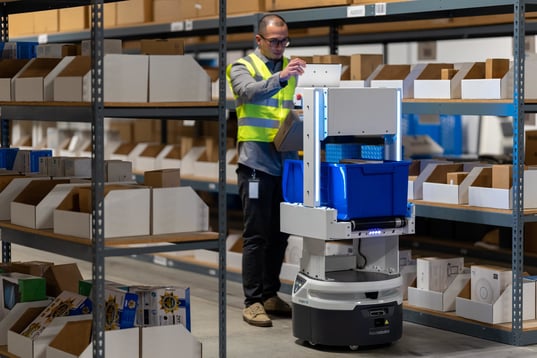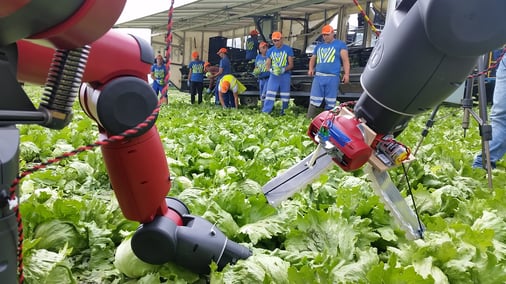What’s New in Robotics? 06.10.2023

Posted on Oct 06, 2023 7:00 AM. 10 min read time
News briefs for the week take a look at robots going from being fast learners to super-fast learners when powered by Large Behavior Models or LBMs, how much humans can benefit from working alongside robots (MIT measured the results), why and how industrial robots are scrambling for 5G, how Californian agbots are pioneering new agtech and new academic courses in agbotics, and, for better or worse, the return of Shane Wightman and his TikTok robot barber.
Robots suddenly go from fast to extra-fast learners
In the past 18 months, humanoid and industrial robots have become fast learners using LLMs (large language models) and reinforcement learning. Essentially, it’s all about controlling industrial robots (or any robot) with language. ChatGPT is one.
 Now, however, a recent discovery at the Los Altos, CA-based Toyota Research Institute (TRI) may well make robots learning via LLMs more than a bit passé. LBMs (Large Behavior Models) have supplanted LLMs for teaching. TRI calls its new generative AI technology (developed in conjunction with MIT and Columbia University) Diffusion Policy.
Now, however, a recent discovery at the Los Altos, CA-based Toyota Research Institute (TRI) may well make robots learning via LLMs more than a bit passé. LBMs (Large Behavior Models) have supplanted LLMs for teaching. TRI calls its new generative AI technology (developed in conjunction with MIT and Columbia University) Diffusion Policy.
“It’s remarkable how fast it works,” says TRI CEO and Chief Scientist Gill Pratt. “In machine learning, up until quite recently there was a tradeoff, where it works, but you need millions of training cases. When you’re doing physical things, you don’t have time for that many, and the machine will break down before you get to 10,000. Now it seems that we only need dozens.”
Researchers at TRI are using Diffusion Policy to quickly teach robots new, dexterous skills by “building large behavior models for robots, analogous to the large language models that have recently revolutionized conversational AI.”
Previous state-of-the-art techniques to teach robots new behaviors were slow, inconsistent, inefficient, and often limited to narrowly defined tasks performed in highly constrained environments. Roboticists needed to spend many hours writing sophisticated code or using numerous trial and error cycles to program behaviors.
TRI has already taught robots more than 60 difficult, dexterous skills using the new approach, including pouring liquids, using tools, and manipulating deformable objects. These achievements were realized without writing a single line of new code. The only change was supplying the robot with new data.
In a new video [see video], TRI shows off how its AI robot was able to master complex tasks in a matter of hours, something that many previously thought impossible.
Human benefits from working with robots
In what seems like a reversal to the notion of “lights out manufacturing with little to no human workers, a recent MIT Sloan School study seems to have turned back the tide on the benefits of human-robot collaboration.
Manish Walia, writing in TechExpert puts it plainly: “The idea of having a factory that runs completely automatically, without any workers, just using machines and maintenance, hasn’t worked out. A lot of things that happen in a factory need human creativity, learning, and the ability to adjust.”
 “The integration of robots that comprehend human dynamics accelerates task execution and minimizes unproductive intervals,” say the authors of MIT’s How Robots Can Enhance Performance Management for Humans.
“The integration of robots that comprehend human dynamics accelerates task execution and minimizes unproductive intervals,” say the authors of MIT’s How Robots Can Enhance Performance Management for Humans.
Interestingly, human-robot collaboration is more important in manufacturing than previously thought. The study highlights “the transformative potential of cohesive human-robot teamwork.” Robots adapting to human cues bring about an increase and improvement in efficiency. Plus, the realization of an 85% reduction in idle time is particularly remarkable.
In addition, the report says “the adoption of robots is improving companies’ ability to recognize and reward good employee performance.”
“We have found,” write the authors, “that companies that adopt robots improve their ability to measure human performance.
As robots are increasingly being incorporated into the workforce, one unexpected benefit is the ability to better assess the performance of their human counterparts on an individual level.
“Based on their research, the authors describe how having humans and robots work side by side can help busy managers more easily measure and improve workers’ performance and identify and reward top contributors.”
That, of course, might be a double-edged sword for workers who may feel they are being spied upon in some sort of new-age Taylorism.
Industrial robots scramble for 5G
Industrial robots in factories and warehouses are consumers on the hunt for more, as in more electricity and more Internet.
Nick Leonard, senior vice president of product for Norfolk, Va.-based logistics software provider SVT Robotics, said: “Often sites are running essentially their phone infrastructure or just basic Internet for email browsing.”
Leonard explains further that “upgrading a warehouse’s Internet can be as simple as calling the internet provider to increase the bandwidth or as complicated as installing fiber-optic cable lines, antennas, and server rooms, depending on the type of automation being added and the existing connections.”
 One thing is for sure, all those autonomous mobile robots (AMRs), forklifts and other robot platforms zipping around massive distribution centers need high-speed Internet in order to function properly. A number of the use cases from Industry 4.0, around smart manufacturing, logistics, warehouse automation energies and utilities, smart grids, and defect detection represent more than 60% of the use cases for private 5G
One thing is for sure, all those autonomous mobile robots (AMRs), forklifts and other robot platforms zipping around massive distribution centers need high-speed Internet in order to function properly. A number of the use cases from Industry 4.0, around smart manufacturing, logistics, warehouse automation energies and utilities, smart grids, and defect detection represent more than 60% of the use cases for private 5G
As companies expand their operations and upgrade their equipment, things tend to get complex and sophisticated in a hurry, like adding vision systems, edge computing and other bandwidth-needy technology.
A recent Wall Street Journal’s headline put it well: Where’s the Signal? Warehouse Robots Are Searching for Stronger Internet Connections.
For industry, 5G offers the promise of faster speeds, lower latency, and greater potential for unlocking the power of edge computing — but only if the devices can connect.
Telco behemoth, New York-based Verizon has developed a platform (Network Alpha Factory) for migrating millions of customers to its next-generation networks such as 5G, Cloud Connectivity, and Fixed Wireless Access — with minimal disruption.
Agbots pioneer both farming and agtech ed
 Nowhere in America is robotics so quickly evolving an entire industry as it’s doing with agriculture in Salinas Valley, California. There, everyone, including farmers, growers, agbot developers, equipment manufacturers, state and federal officials, workers' unions, as well as academia, are all on the same page when it comes to automation: We need bigtime help from robotics…and quickly!
Nowhere in America is robotics so quickly evolving an entire industry as it’s doing with agriculture in Salinas Valley, California. There, everyone, including farmers, growers, agbot developers, equipment manufacturers, state and federal officials, workers' unions, as well as academia, are all on the same page when it comes to automation: We need bigtime help from robotics…and quickly!
The International Forum for Agricultural Robotics, or FIRA, just concluded its Salinas tradeshow with organizations coming from all over the world to demonstrate what their robots can do. According to the Western Growers Association, growers and farmers are looking and buying.
Seems no one in Salinas Valley is worried about robots taking their jobs.
 In fact, it’s quite the opposite as the AgTechX Ed Initiative was there as well, which is a statewide effort, led by the Western Growers Center for Innovation & Technology (WGCIT) and the California Department of Food and Agriculture (CDFA) “to cultivate a future workforce with the skills and knowledge needed to navigate emerging on-farm technology.”
In fact, it’s quite the opposite as the AgTechX Ed Initiative was there as well, which is a statewide effort, led by the Western Growers Center for Innovation & Technology (WGCIT) and the California Department of Food and Agriculture (CDFA) “to cultivate a future workforce with the skills and knowledge needed to navigate emerging on-farm technology.”
It is well-understood and accepted that workers for stoop labor in the fields and orchards of Salinas Valley are extremely scarce. Agbots are seen as the only long-term answer.
Walt Duflock, who’s the newly hired head of innovation with the Western Growers Association, sees plenty of agbots in evidence but not enough people.
“The future of farming doesn't just mean technology, it involves the youth of the community as well,” he said during FIRA. “We better get some kids who can build these robots, service these robots, take care of these robots, not just at the manufacturing plant but here in the fields. We're working on a community college program state-wide that will train all these kids on the new stuff. Going to take us a while, but we're starting it.”
Duflock is working toward Salinas becoming a hotbed for new robotic solutions.”
TikTok robot cuts hair, sort of
The world first met Shane Wighton and his hairdresser robot during the COVID shut-in days. Remember? News shows had him on as the robot was snipping his thick locks.
On YouTube, Wighton billed himself as an engineer and named his show Stuff Built Here, which had a YouTube audience of 17 million. “According to the channel’s description, it is “about taking things that you can buy anywhere and making them yourself to save money.”
Well, now he’s back, with AI and Machine Learning in his promo. Natch, AI and a robot barber could be even bigger than in his YouTube days.
“The Raspberry Pi-powered robot barber detects and separates hair parts using machine learning methods. It has a pair of scissors for cutting the hair, a suction system for pulling the hair tight, and an adjustable lever that rotates around the head.
“It is equipped with sensors that let it detect the contours of Wighton’s head in order to make an equal cut. The machine can separate parts of hair and trim it to the desired length, much like a hairdresser. The device is constructed mainly of off-the-shelf materials and 3D-printed elements.
“While there are concerns regarding the quality of haircuts [see TikTok video] and safety issues, these are expected to be resolved with more technical advancements. The robot barber, like any new technology, will take time to become mainstream, but it is a prospect that cannot be overlooked.”
Here’s hoping. Enjoy the video (it’s funny…and instructive for newbie robot builders)


Leave a comment